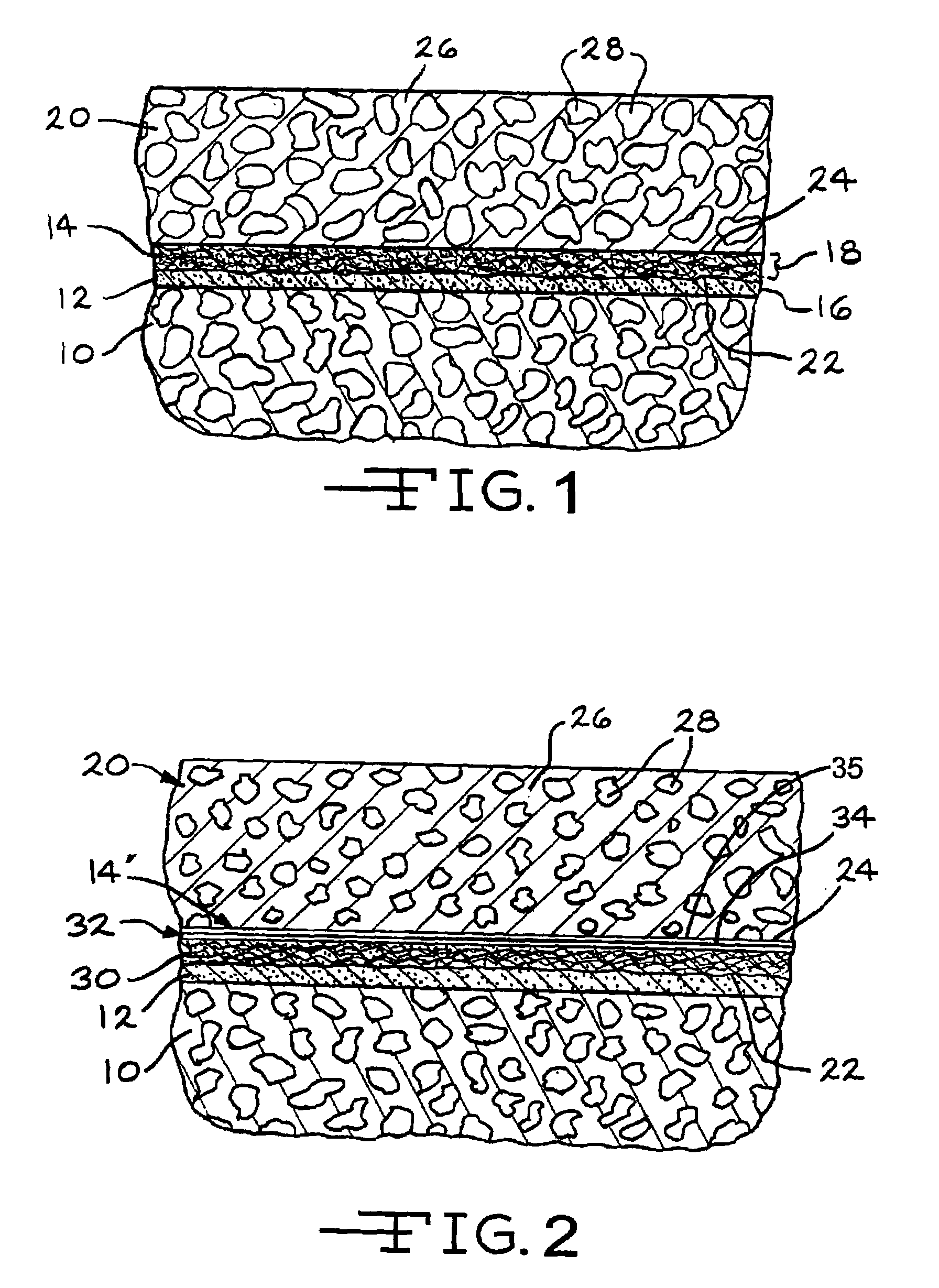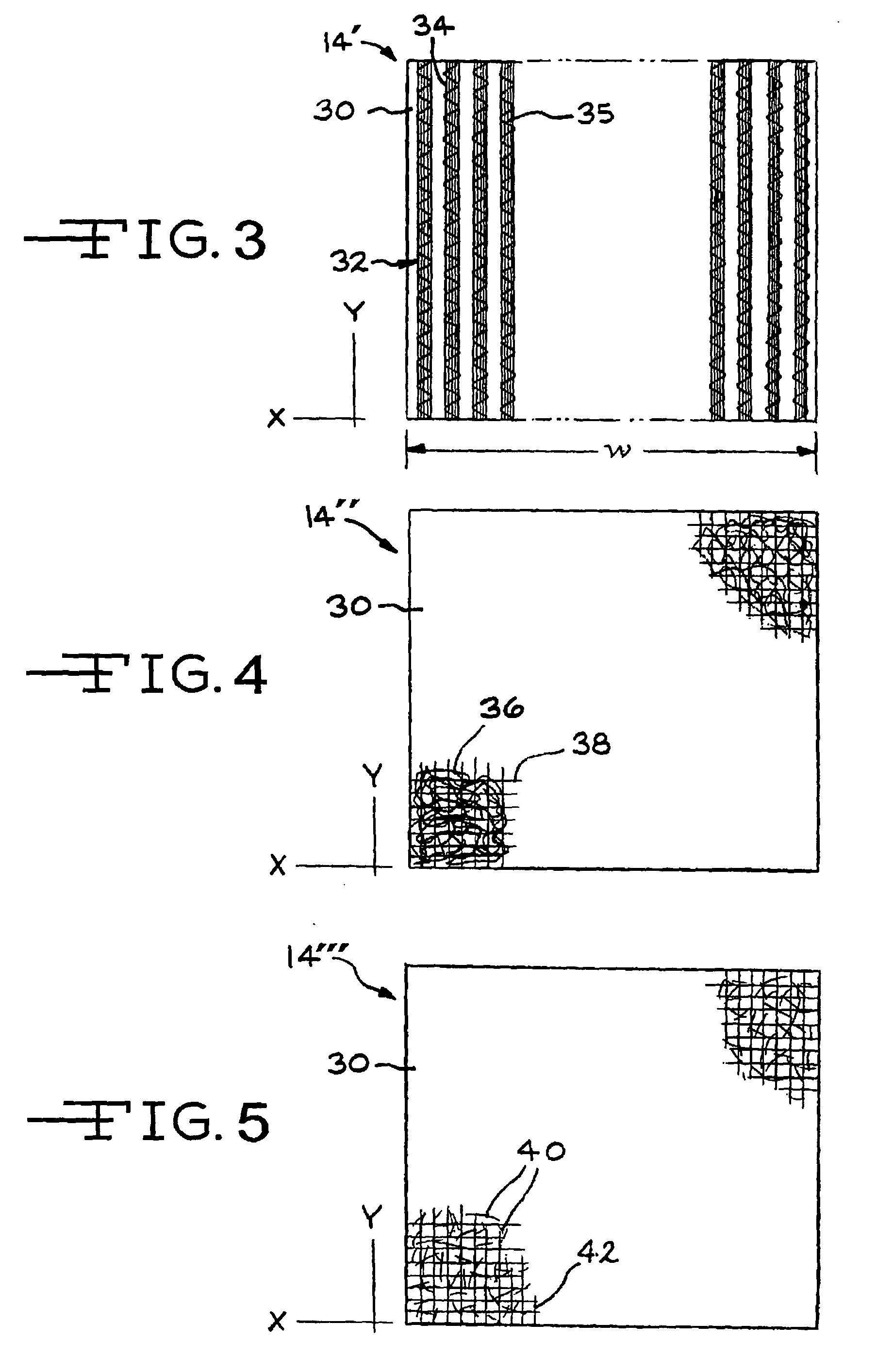Mats for use in paved surfaces
a technology for paving surfaces and mats, applied in the field of mats, can solve the problems of deterioration, cracking, and deterioration of paved surfaces, and achieve the effect of preventing cracking
- Summary
- Abstract
- Description
- Claims
- Application Information
AI Technical Summary
Benefits of technology
Problems solved by technology
Method used
Image
Examples
first embodiment
[0051]In a first embodiment, shown in FIG. 3, the first layer 30 of the mat 14′ is made of glass fibers, and has a width w. Such a glass fiber mat is thermally stable, and does not melt and / or shrink when it is exposed to hot paving material. At the levels of strain encountered in the movement of pavements, the glass fiber mat comprising the first layer 30 carries much higher tensile loads than the polypropylene mats typically used. Preferably, the glass fiber mat has a basis weight within a range of from about 0.5 to about 10 pounds per hundred square feet (about 0.02 kg / m2 to about 0.42 kg / m2), and more preferably from about 1 to about 5 pounds per hundred square feet (about 0.04 kg / m2 to about 0.21 kg / m2).
[0052]As shown in FIG. 3, the second layer 32 includes a plurality of continuous strands 34 of glass fibers disposed on a surface of the first layer 30. The strands 34 can be oriented in any desired direction relative to the first layer 30, and relative to one another. In the em...
second embodiment
[0056]the two-layer mat is generally shown at 14″ in FIG. 4. The mat 14″ includes the first layer 30, and a second layer 36. The second layer 36 is formed from a randomly-oriented continuous strand of glass fiber applied to a surface of the first layer 30 by any conventional method. The layer 36 formed from the continuous strand of glass fiber is commonly known as a continuous filament mat (CFM). The second layer 36 can have any desired weight. Preferably, the second layer 36 weighs within the range of from about 4.5 to about 45 ounces per square yard (154 to 1535 grams / square meter) of mat 14″. More preferably, the second layer 36 weighs within the range of from about 9.0 to about 18 ounces per square yard (307 to 614 grams / square meter) of mat 14″.
[0057]The second layer 36 can be attached to the first layer 30 by any desired method. Knitting is a preferred method of attaching the second layer 36 to the first layer 30, as described above for attaching the second layer 32 to the fir...
third embodiment
[0058]the two-layer mat is generally shown at 14′″ in FIG. 5. The mat 14′″ includes the first layer 30, and a second layer 40. The second layer 40 is formed from randomly-oriented chopped strands of glass fiber applied to a surface of the first layer 30 by any conventional method. The random orientation of the chopped strands of the layer 40 provide improved strength to the mat 14′″ in a first, x, dimension and a second, y, dimension. The second layer 40 can include chopped strands of any desired length. Preferably, the chopped strands have a length within the range of from about 0.5 to about 8.0 inches (0.013 to 0.20 meters). More preferably, the chopped stands have a length within the range of from about 2.0 to about 4.0 inches (0.05 to 0.1 meters). Most preferably, the chopped stands have a length of about 2.0 inches (0.05 meters).
[0059]The second layer 40 can have any desired weight. Preferably, the second layer 40 has a weight within the range of from about 0.5 to about 15 ounc...
PUM
| Property | Measurement | Unit |
|---|---|---|
| melting point | aaaaa | aaaaa |
| elongation | aaaaa | aaaaa |
| elongation | aaaaa | aaaaa |
Abstract
Description
Claims
Application Information
 Login to View More
Login to View More - R&D
- Intellectual Property
- Life Sciences
- Materials
- Tech Scout
- Unparalleled Data Quality
- Higher Quality Content
- 60% Fewer Hallucinations
Browse by: Latest US Patents, China's latest patents, Technical Efficacy Thesaurus, Application Domain, Technology Topic, Popular Technical Reports.
© 2025 PatSnap. All rights reserved.Legal|Privacy policy|Modern Slavery Act Transparency Statement|Sitemap|About US| Contact US: help@patsnap.com



